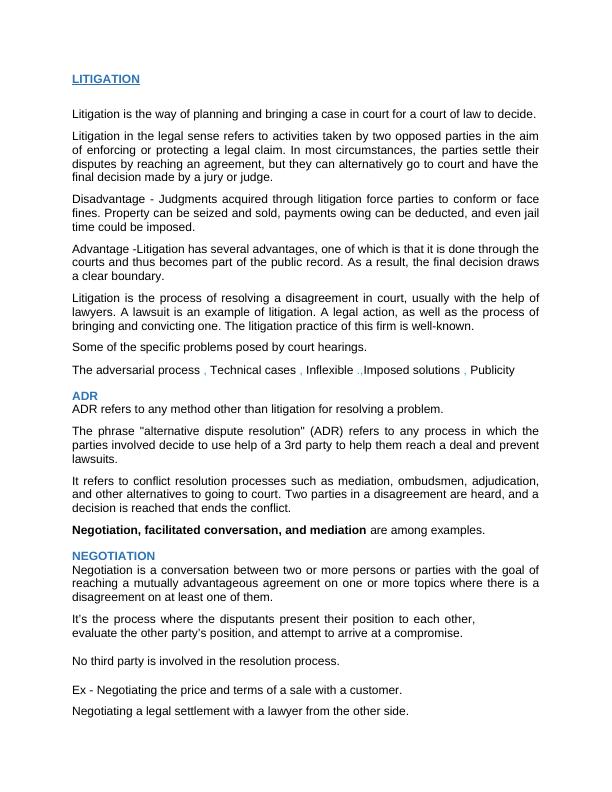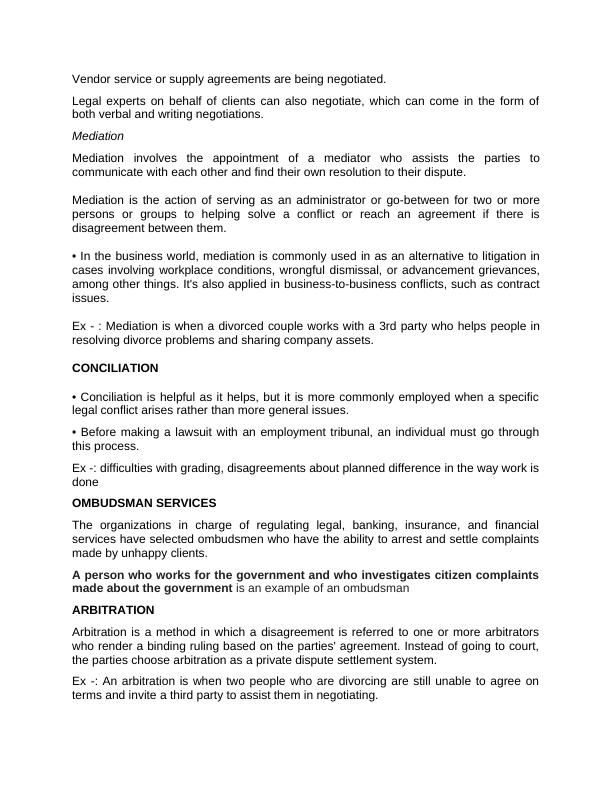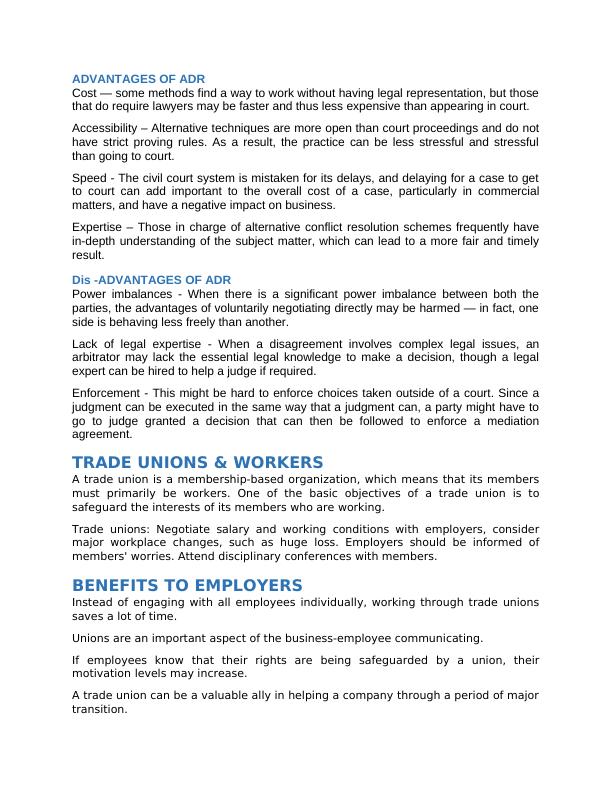Judgments Acquired Through Litigation Force
Added on 2022-08-17
7 Pages2217 Words14 Views
LITIGATION
Litigation is the way of planning and bringing a case in court for a court of law to decide.
Litigation in the legal sense refers to activities taken by two opposed parties in the aim
of enforcing or protecting a legal claim. In most circumstances, the parties settle their
disputes by reaching an agreement, but they can alternatively go to court and have the
final decision made by a jury or judge.
Disadvantage - Judgments acquired through litigation force parties to conform or face
fines. Property can be seized and sold, payments owing can be deducted, and even jail
time could be imposed.
Advantage -Litigation has several advantages, one of which is that it is done through the
courts and thus becomes part of the public record. As a result, the final decision draws
a clear boundary.
Litigation is the process of resolving a disagreement in court, usually with the help of
lawyers. A lawsuit is an example of litigation. A legal action, as well as the process of
bringing and convicting one. The litigation practice of this firm is well-known.
Some of the specific problems posed by court hearings.
The adversarial process , Technical cases , Inflexible .,Imposed solutions , Publicity
ADR
ADR refers to any method other than litigation for resolving a problem.
The phrase "alternative dispute resolution" (ADR) refers to any process in which the
parties involved decide to use help of a 3rd party to help them reach a deal and prevent
lawsuits.
It refers to conflict resolution processes such as mediation, ombudsmen, adjudication,
and other alternatives to going to court. Two parties in a disagreement are heard, and a
decision is reached that ends the conflict.
Negotiation, facilitated conversation, and mediation are among examples.
NEGOTIATION
Negotiation is a conversation between two or more persons or parties with the goal of
reaching a mutually advantageous agreement on one or more topics where there is a
disagreement on at least one of them.
It’s the process where the disputants present their position to each other,
evaluate the other party’s position, and attempt to arrive at a compromise.
No third party is involved in the resolution process.
Ex - Negotiating the price and terms of a sale with a customer.
Negotiating a legal settlement with a lawyer from the other side.
Litigation is the way of planning and bringing a case in court for a court of law to decide.
Litigation in the legal sense refers to activities taken by two opposed parties in the aim
of enforcing or protecting a legal claim. In most circumstances, the parties settle their
disputes by reaching an agreement, but they can alternatively go to court and have the
final decision made by a jury or judge.
Disadvantage - Judgments acquired through litigation force parties to conform or face
fines. Property can be seized and sold, payments owing can be deducted, and even jail
time could be imposed.
Advantage -Litigation has several advantages, one of which is that it is done through the
courts and thus becomes part of the public record. As a result, the final decision draws
a clear boundary.
Litigation is the process of resolving a disagreement in court, usually with the help of
lawyers. A lawsuit is an example of litigation. A legal action, as well as the process of
bringing and convicting one. The litigation practice of this firm is well-known.
Some of the specific problems posed by court hearings.
The adversarial process , Technical cases , Inflexible .,Imposed solutions , Publicity
ADR
ADR refers to any method other than litigation for resolving a problem.
The phrase "alternative dispute resolution" (ADR) refers to any process in which the
parties involved decide to use help of a 3rd party to help them reach a deal and prevent
lawsuits.
It refers to conflict resolution processes such as mediation, ombudsmen, adjudication,
and other alternatives to going to court. Two parties in a disagreement are heard, and a
decision is reached that ends the conflict.
Negotiation, facilitated conversation, and mediation are among examples.
NEGOTIATION
Negotiation is a conversation between two or more persons or parties with the goal of
reaching a mutually advantageous agreement on one or more topics where there is a
disagreement on at least one of them.
It’s the process where the disputants present their position to each other,
evaluate the other party’s position, and attempt to arrive at a compromise.
No third party is involved in the resolution process.
Ex - Negotiating the price and terms of a sale with a customer.
Negotiating a legal settlement with a lawyer from the other side.

Vendor service or supply agreements are being negotiated.
Legal experts on behalf of clients can also negotiate, which can come in the form of
both verbal and writing negotiations.
Mediation
Mediation involves the appointment of a mediator who assists the parties to
communicate with each other and find their own resolution to their dispute.
Mediation is the action of serving as an administrator or go-between for two or more
persons or groups to helping solve a conflict or reach an agreement if there is
disagreement between them.
• In the business world, mediation is commonly used in as an alternative to litigation in
cases involving workplace conditions, wrongful dismissal, or advancement grievances,
among other things. It's also applied in business-to-business conflicts, such as contract
issues.
Ex - : Mediation is when a divorced couple works with a 3rd party who helps people in
resolving divorce problems and sharing company assets.
CONCILIATION
• Conciliation is helpful as it helps, but it is more commonly employed when a specific
legal conflict arises rather than more general issues.
• Before making a lawsuit with an employment tribunal, an individual must go through
this process.
Ex -: difficulties with grading, disagreements about planned difference in the way work is
done
OMBUDSMAN SERVICES
The organizations in charge of regulating legal, banking, insurance, and financial
services have selected ombudsmen who have the ability to arrest and settle complaints
made by unhappy clients.
A person who works for the government and who investigates citizen complaints
made about the government is an example of an ombudsman
ARBITRATION
Arbitration is a method in which a disagreement is referred to one or more arbitrators
who render a binding ruling based on the parties' agreement. Instead of going to court,
the parties choose arbitration as a private dispute settlement system.
Ex -: An arbitration is when two people who are divorcing are still unable to agree on
terms and invite a third party to assist them in negotiating.
Legal experts on behalf of clients can also negotiate, which can come in the form of
both verbal and writing negotiations.
Mediation
Mediation involves the appointment of a mediator who assists the parties to
communicate with each other and find their own resolution to their dispute.
Mediation is the action of serving as an administrator or go-between for two or more
persons or groups to helping solve a conflict or reach an agreement if there is
disagreement between them.
• In the business world, mediation is commonly used in as an alternative to litigation in
cases involving workplace conditions, wrongful dismissal, or advancement grievances,
among other things. It's also applied in business-to-business conflicts, such as contract
issues.
Ex - : Mediation is when a divorced couple works with a 3rd party who helps people in
resolving divorce problems and sharing company assets.
CONCILIATION
• Conciliation is helpful as it helps, but it is more commonly employed when a specific
legal conflict arises rather than more general issues.
• Before making a lawsuit with an employment tribunal, an individual must go through
this process.
Ex -: difficulties with grading, disagreements about planned difference in the way work is
done
OMBUDSMAN SERVICES
The organizations in charge of regulating legal, banking, insurance, and financial
services have selected ombudsmen who have the ability to arrest and settle complaints
made by unhappy clients.
A person who works for the government and who investigates citizen complaints
made about the government is an example of an ombudsman
ARBITRATION
Arbitration is a method in which a disagreement is referred to one or more arbitrators
who render a binding ruling based on the parties' agreement. Instead of going to court,
the parties choose arbitration as a private dispute settlement system.
Ex -: An arbitration is when two people who are divorcing are still unable to agree on
terms and invite a third party to assist them in negotiating.

ADVANTAGES OF ADR
Cost — some methods find a way to work without having legal representation, but those
that do require lawyers may be faster and thus less expensive than appearing in court.
Accessibility – Alternative techniques are more open than court proceedings and do not
have strict proving rules. As a result, the practice can be less stressful and stressful
than going to court.
Speed - The civil court system is mistaken for its delays, and delaying for a case to get
to court can add important to the overall cost of a case, particularly in commercial
matters, and have a negative impact on business.
Expertise – Those in charge of alternative conflict resolution schemes frequently have
in-depth understanding of the subject matter, which can lead to a more fair and timely
result.
Dis -ADVANTAGES OF ADR
Power imbalances - When there is a significant power imbalance between both the
parties, the advantages of voluntarily negotiating directly may be harmed — in fact, one
side is behaving less freely than another.
Lack of legal expertise - When a disagreement involves complex legal issues, an
arbitrator may lack the essential legal knowledge to make a decision, though a legal
expert can be hired to help a judge if required.
Enforcement - This might be hard to enforce choices taken outside of a court. Since a
judgment can be executed in the same way that a judgment can, a party might have to
go to judge granted a decision that can then be followed to enforce a mediation
agreement.
TRADE UNIONS & WORKERS
A trade union is a membership-based organization, which means that its members
must primarily be workers. One of the basic objectives of a trade union is to
safeguard the interests of its members who are working.
Trade unions: Negotiate salary and working conditions with employers, consider
major workplace changes, such as huge loss. Employers should be informed of
members' worries. Attend disciplinary conferences with members.
BENEFITS TO EMPLOYERS
Instead of engaging with all employees individually, working through trade unions
saves a lot of time.
Unions are an important aspect of the business-employee communicating.
If employees know that their rights are being safeguarded by a union, their
motivation levels may increase.
A trade union can be a valuable ally in helping a company through a period of major
transition.
Cost — some methods find a way to work without having legal representation, but those
that do require lawyers may be faster and thus less expensive than appearing in court.
Accessibility – Alternative techniques are more open than court proceedings and do not
have strict proving rules. As a result, the practice can be less stressful and stressful
than going to court.
Speed - The civil court system is mistaken for its delays, and delaying for a case to get
to court can add important to the overall cost of a case, particularly in commercial
matters, and have a negative impact on business.
Expertise – Those in charge of alternative conflict resolution schemes frequently have
in-depth understanding of the subject matter, which can lead to a more fair and timely
result.
Dis -ADVANTAGES OF ADR
Power imbalances - When there is a significant power imbalance between both the
parties, the advantages of voluntarily negotiating directly may be harmed — in fact, one
side is behaving less freely than another.
Lack of legal expertise - When a disagreement involves complex legal issues, an
arbitrator may lack the essential legal knowledge to make a decision, though a legal
expert can be hired to help a judge if required.
Enforcement - This might be hard to enforce choices taken outside of a court. Since a
judgment can be executed in the same way that a judgment can, a party might have to
go to judge granted a decision that can then be followed to enforce a mediation
agreement.
TRADE UNIONS & WORKERS
A trade union is a membership-based organization, which means that its members
must primarily be workers. One of the basic objectives of a trade union is to
safeguard the interests of its members who are working.
Trade unions: Negotiate salary and working conditions with employers, consider
major workplace changes, such as huge loss. Employers should be informed of
members' worries. Attend disciplinary conferences with members.
BENEFITS TO EMPLOYERS
Instead of engaging with all employees individually, working through trade unions
saves a lot of time.
Unions are an important aspect of the business-employee communicating.
If employees know that their rights are being safeguarded by a union, their
motivation levels may increase.
A trade union can be a valuable ally in helping a company through a period of major
transition.

End of preview
Want to access all the pages? Upload your documents or become a member.
Related Documents
The Legal Framework and Legal Solutionslg...
|5
|706
|88
Alternative Dispute Resolution in Lawlg...
|11
|2656
|107
Community and Industry Relations Assignment PDFlg...
|3
|1152
|81
Civil Procedure entails the rules governing the steps taken in the process of a civil caselg...
|4
|909
|17
Alternative Dispute Resolution in USAlg...
|6
|1460
|351
Report on Theory and Principles of Conflict Resolutionlg...
|3
|308
|59
